A week ago today I returned from my 12-day trip to Cyprus. I’m still busy processing all my photos, but I’ve picked a small preselection to use here in a first blog post about Cyprus. This is just a taster and brief overview of what I did on the island in terms of dark tourism. Over the coming weeks and months I’ll prepare more blog posts about specific places, and of course I will also have to substantially expand the current short stub chapter about Cyprus on my main website and add individual chapters about the various specific dark destinations within the country. [UPDATE March 2023: this has meanwhile been done, for both the Republic of Cyprus and North Cyprus; do go and take a look; the links to specific places in the text below are also updates.] For my book Atlas of Dark Destinations it is of course too late for such additions, unfortunately (but maybe if there’s ever to be a second edition I could slot a couple more places in). In the current version the only individual subchapter for Cyprus is about the so-called Green Line.
This is the dividing border and UN-controlled buffer zone between the Republic of Cyprus, the independent state created in 1960 at the end of the British colonial era and now an EU member state, which takes up the southern two thirds of the island, and the “Turkish Republic of Northern Cyprus” (TRNC), created after the 1974 Turkish invasion and a self-declared independent state that is however not recognized by any other country save for Turkey, on which the TRNC heavily depends. The Greek Cypriots in the south consider the north to be an illegally occupied territory.
The Green Line predates the creation of the TRNC and came about after violent ethnic clashes between Greek and Turkish Cypriots in the early 1960s. The name derives from a British officer drawing a line between the two parts on a map in green. And the informal name stuck. The Green Line runs all the way west to east across the country, but it is most notable right in the middle of the capital city, Nicosia. This is indeed the last divided capital in the world and the Green Line in Nicosia has thus been likened to the former Berlin Wall. It looks very different, though. In some places there are watchtowers and gates, at a few points there are little bunkers staffed by UN soldiers, but mostly it consists of simple barriers blocking the roads that once connected the south and the north part of the Old Town. Often these barriers involve sand-filled former oil drums, as in this first photo (same as the featured photo at the top of this post):
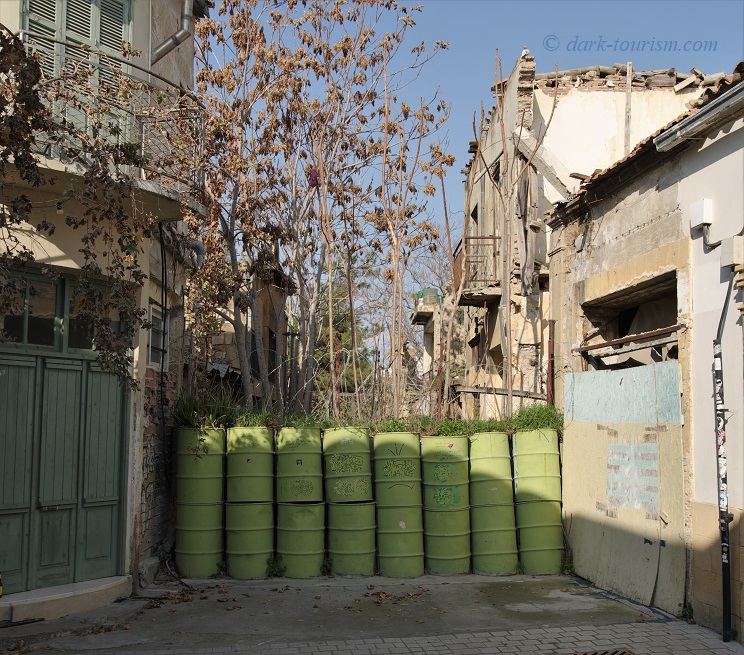
The fact that the oil drums in this picture are indeed green is coincidental. Elsewhere they have other colours, including the blue and white signifying Greek patriotism. A Greek flag is also flying by the Liberation Monument located on one of the bastions of the old Venetian wall that surrounds the Old Town of Nicosia. The monument symbolizes, in rather pompous style, the victorious fight against British colonial rule and the release of the country into freedom:
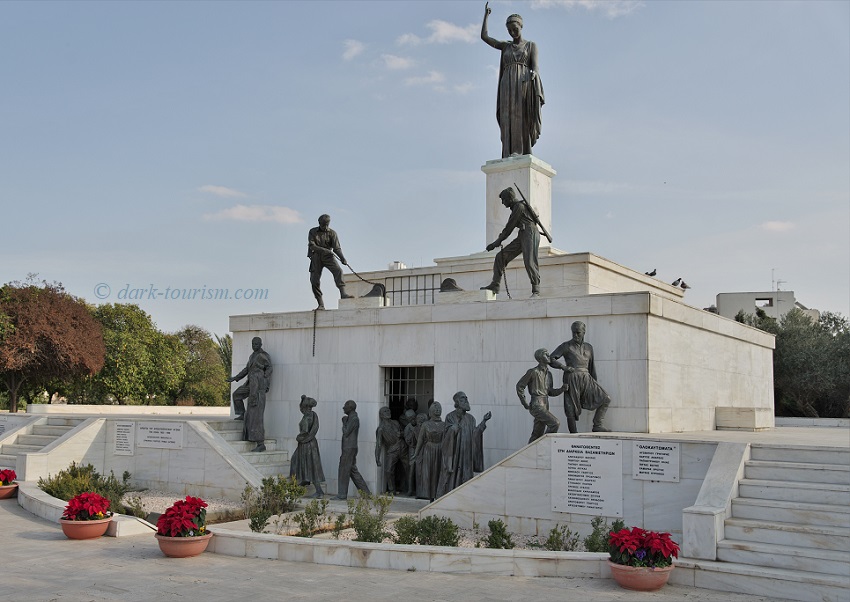
The story of the fight for freedom against the British by the Greek Cypriot paramilitary organization EOKA is told in much detail at the Museum of the National Struggle in the Old Town of Nicosia. The museum full of glorifying heroes’ stories and features loads of historic photos and artefacts such as weapons and personal belongings of individual “martyrs”. On the top floor it also has a chilling reconstruction of the gallows on which the British executed a number of captured EOKA fighters (see also below – under the “Imprisoned Graves”):
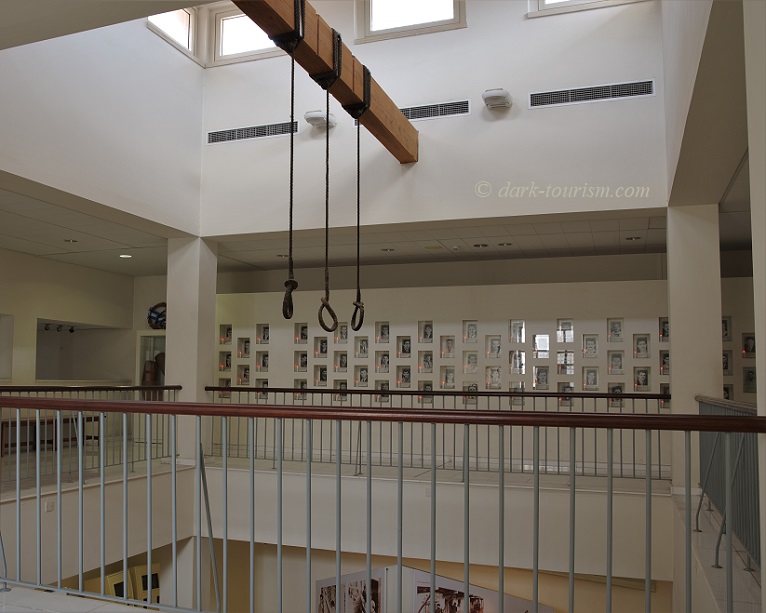
After a few days in Nicosia I walked across to the north using the pedestrian border checkpoint on Ledra Street. From North Nicosia I had organized a hire car, which I then used to drive all the way to Famagusta in the east of the TRNC. This place also has a charming historic Old Town surrounded by Venetian walls, but in terms of dark tourism it is best known for its southern part of the city called Varosha in Greek, or Maras in Turkish. This is one of the world’s most legendary ghost towns.
Varosha used to be the main beach tourism hub of Cyprus prior to 1974 and the ca. three-mile-long beach at Varosha was lined with countless high-rise hotels, while the hinterland had all manner of tourism infrastructure like shops, bars and restaurants. During the 1974 Turkish invasion all inhabitants, mostly Greek Cypriots, had to evacuate … never to return, as Varosha then fell within the Green Line buffer zone. For the decades since the division of the island Varosha had been out of bounds and just lay there abandoned, slowly rotting away, guarded by UN and Turkish military.
From the south Varosha is still totally out of reach, but from the north the main part of Varosha has long formed the incongruous backdrop to one beach still accessible to the public, called somewhat grandiosely Palm Beach (there are indeed a couple of palm trees here, but it’s hardly the tropical paradise the name promises). So I made sure I booked a room at the Palm Beach hotel that overlooks this. This is a view from there over the Palm Beach and Varosha – note the war damage on the back facade of the first of the abandoned high-rise hotels!
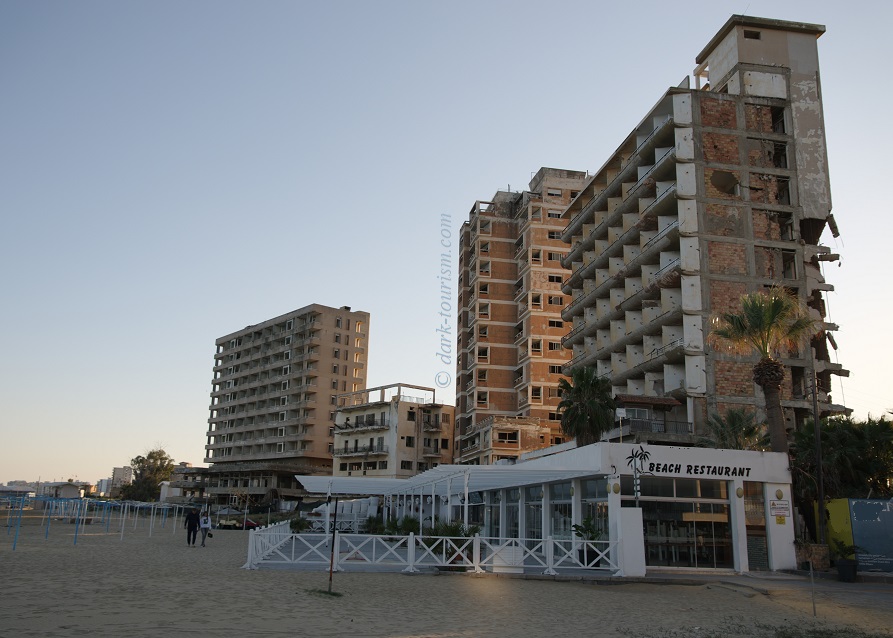
These large hotel ruins are within the ‘forbidden zone’ as various signs point out and until recently there used to be a military-guarded, barbed-wire-reinforced barrier at the end of the beach reaching into the water. If you’ve seen the Netflix series “Dark Tourist” you may remember the fruitless efforts of the series’ presenter to dodge that barrier and illegally infiltrate Varosha – a foolhardy gimmick for which he very nearly got arrested.
Then in late 2020, the Turks partially reopened Varosha to visitors, including another part of its beach. This move was highly controversial and is seen by the Greek Cypriots as a violation of the UN ceasefire agreement. The UN also condemned it. Yet, contentious as it may be, for dark tourists this opened up the chance to go and see this fabulous ghost town from close up and that legally. In fact, the Turks constructed a “tourist route” along a newly paved tarmac road (which is somewhat unfittingly wide). For safety reasons you are not allowed to enter any buildings, whose entrances are all barricaded anyway. But you can get quite close up. I spent well over four hours in Varosha and took more photos in that space of time than I have anywhere else ever before (except perhaps for Pripyat on my second and third visits). I’ll make a proper Varosha blog post and photo essay soon. Here I’ll just give you two more tasters. The first one is of a stretch of a road branching off the tourist route, so you can see the full ghost-town-ness of this part:
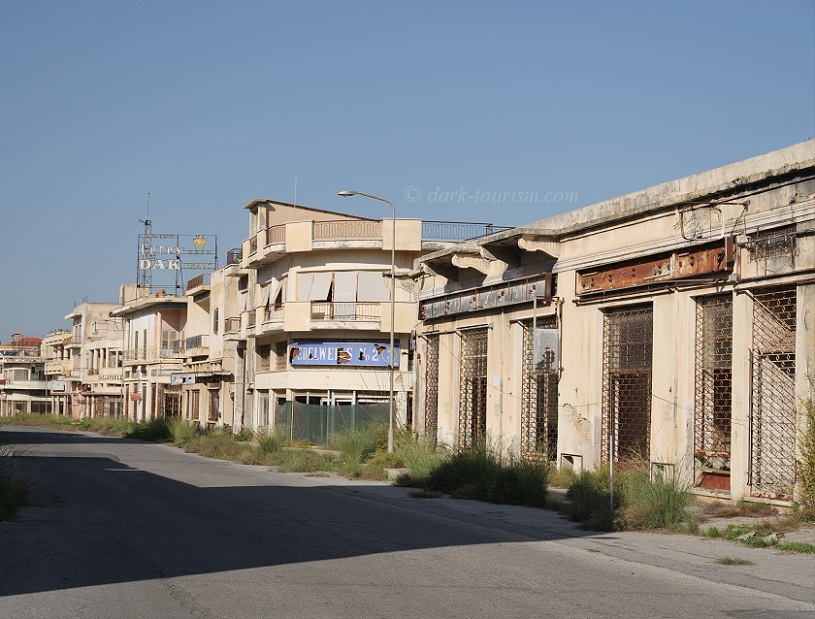
And here is a photo of a remnant of a shop that gives a clear sign that it dates from a long bygone pre-digital era of analogue film photography:
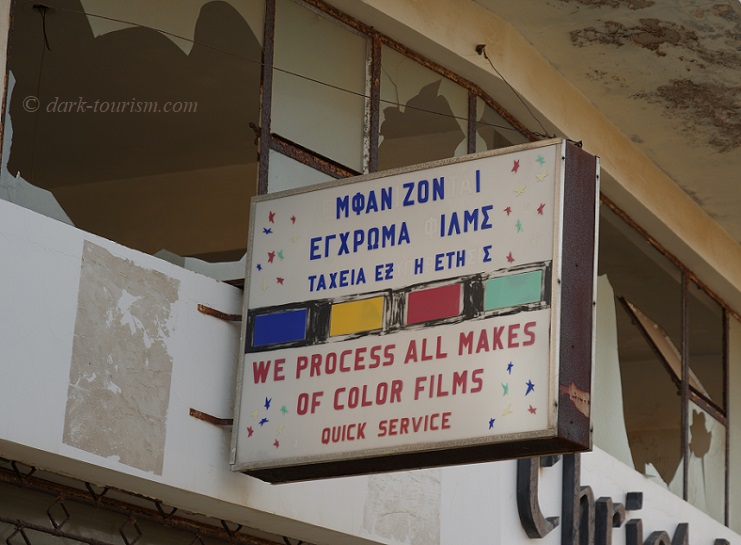
Other than Varosha, the TRNC also offered something for the urbex-inclined dark tourist at the other, western end of the territory, where I drove the next day, namely to a huge abandoned former copper loading jetty jutting far into the sea at Gemikonağı, plus the ghost-town-y associated infrastructure on land. Here’s a photo:

Further inland you can also witness the post-apocalyptic scarred landscapes of the former copper mines themselves, with all the colourful pollution they left behind. I saw such an ex-mine complex from the car but there was nowhere to stop so I couldn’t take any photos (but see below for an equivalent in the south!).
From there I drove back to North Nicosia, where I visited the “Museum of Barbarism” before returning the hire car. This drastically named museum is housed in a building that was the site of a massacre of a Turkish Cypriot family at the hands of Greek Cypriot EOKA members. So to this day it carries a strong propagandistic anti-Greek message. In fact it has been completely revamped and modernized only last year! There aren’t many displays of authentic artefacts, but those few there are include these victims’ shoes (always a poignant display at atrocity-related museums):

I stayed another two nights in North Nicosia and on my second day there I went to see the Turkish equivalent of the Greek Cypriot Museum of the National Struggle, called here on the Turkish side the “National Struggle Museum” (Monty Python fans may feel reminded of the “Judean People’s Front” vs. “People’s Front of Judea” scene in the movie “The Life of Brian”). The Turkish National Struggle Museum is much less about the fight for independence from British colonialism but has a focus on the post-independence ethnic violence in the early 1960s, with strong language to accompany the coverage (expressions like “bloodthirsty Greeks” abound). It also focuses on the Turkish military “liberation” of Northern Cyprus in 1974 and paints a rosy picture of the TRNC in general. I found the exhibition quite over-the-top in a somewhat North-Korea-esque fashion … but there were no other visitors when I was there. Here’s a photo of one of the main halls:
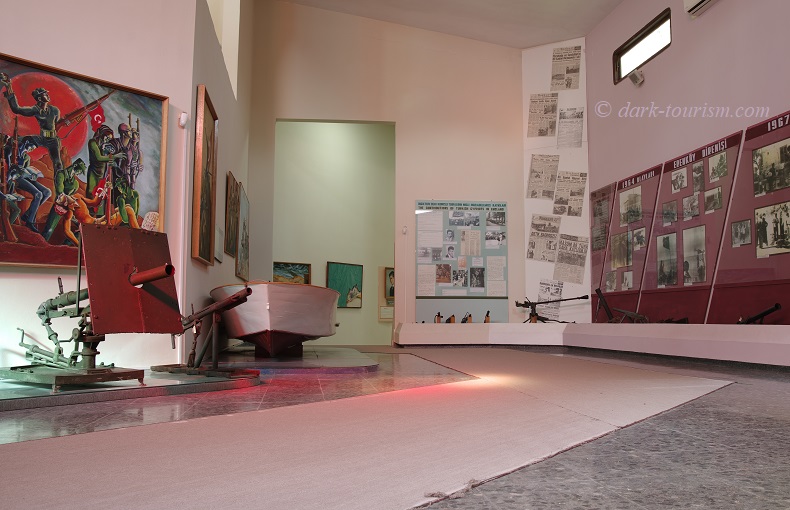
The next day I walked back through the border checkpoint at Ledra Street into southern Nicosia where I had another four nights. The first day I just mooched around the Old Town and tried to see a couple of art galleries with supposedly politically charged exhibits, but I found them all closed – probably because the day before had been a public holiday.
On the Sunday came another highlight of the whole trip and something that instigated it in the first place. Here’s the background: last spring I was contacted by a Russian guy who lives and works in Limassol, southern Cyprus, who had purchased my book and found that the island could have deserved more than just the chapter about the Green Line – and he promptly suggested various other dark sites, some of them quite obscure and never mentioned in any guidebooks. We had a detailed email exchange after that and when it came to planning this Cyprus trip he offered to drive me to some of the places that are otherwise difficult to reach.
So on the Sunday he, two Russian friends of his, my wife and myself formed a merry little dark-tourist group and had a fabulous half-day excursion. The first stop was at a former concentration camp in which the British colonial military incarcerated (and at times tortured) captured EOKA fighters during the 1955-1959 liberation struggle. There were in fact six such camps for political prisoners, of which only two partially survive today. The larger one is Kokkinotrimithia not far from Nicosia. The site is today administered by former EOKA veterans and used for all manner of commemorative gatherings, but it is not normally open to the general public. Yet my Russian contact in Cyprus made special arrangements and so we were allowed in. Here’s a photo of the main section of the camp with its characteristic Nissen-hut like barracks and barbed wire fences:
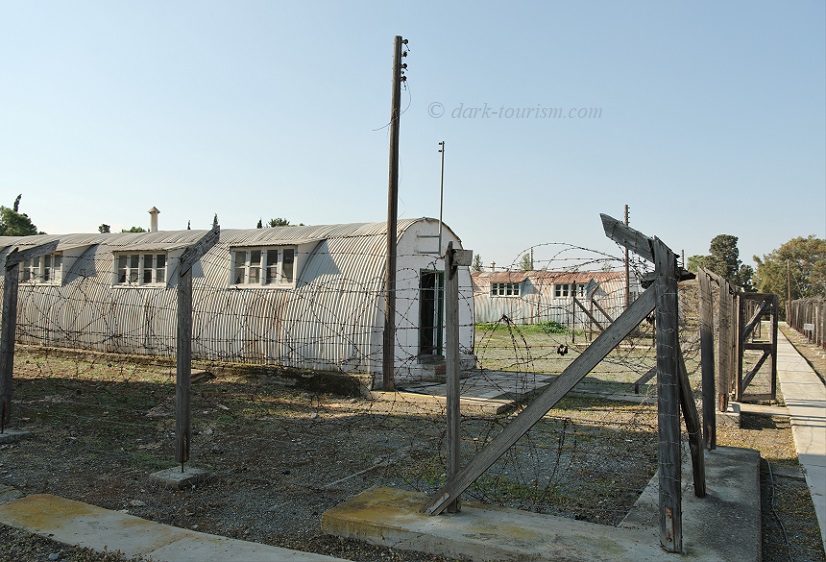
After that we drove on to the abandoned mines near Mitsero, where until 1967 the mineral pyrite was extracted. There was one mine tunnel that was left open so that we were able to just walk in. That was quite eerie and I admit I had to overcome memories of nightmares involving getting trapped in such a mine tunnel when it collapses. It was certainly a little adventure. Here’s one of the photos I took, taking advantage of my high-lumen torch (which I had originally bought for Chernobyl):
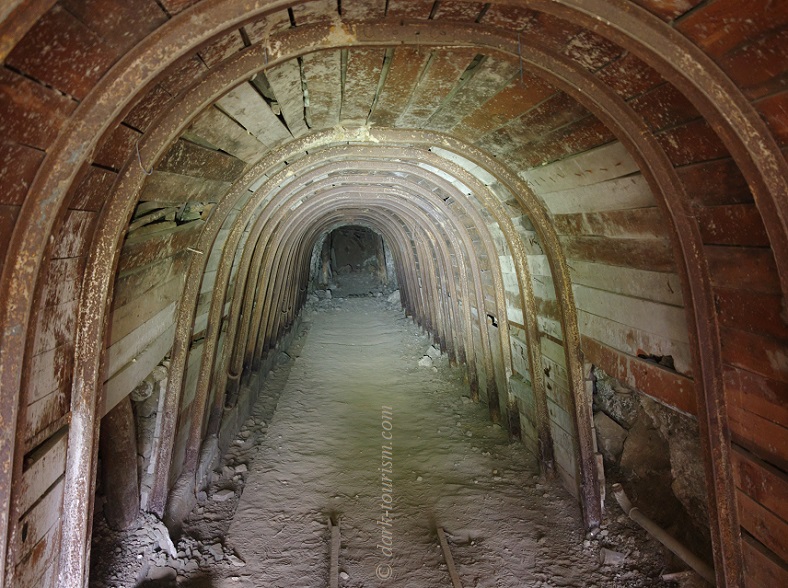
In Germany, the US or other western countries such mine entrances would probably be blocked and “entrance-forbidden” signs would be there – here there was nothing; you could just waltz in. Likewise we were free to clamber around nearby open-air mining infrastructure that is now slowly rusting away.
We then drove on to a former open-cast mine that has by now partially filled with an eerily red lake:
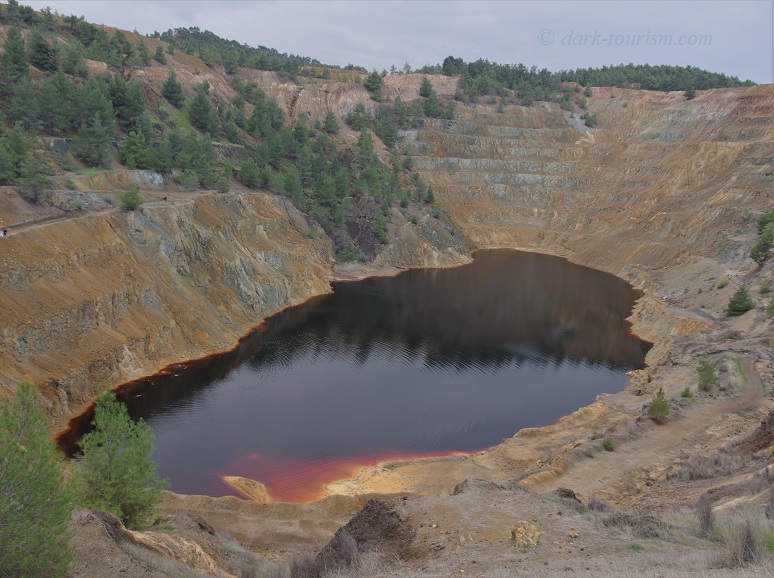
The colour of the water is from sulphuric acid pollution from the mining activities (cf. also Berkeley Pit!) – so you definitely don’t want to go for a dip in these toxic waters. The colour also gave rise to the epithet “Blood Lake”. But there is something beyond metaphor involved here. It was at these sites that – only a few years ago – some of the bodies of victims of a Cypriot serial killer were found, who was eventually captured and sentenced to seven life terms (a record in Cypriot legal history). More on that in a separate post some other time.
Back in Nicosia, my Russian Cyprus contact also recommended I visit the “Imprisoned Graves”. These are the graves of EOKA fighters who were executed by the British colonial military at the main prison of Nicosia during the 1955-1959 independence struggle. For fear of attracting large protesting crowds, the bodies were secretly buried in graves within the prison’s perimeter. And there they still are. Here’s a photo:

The site is still within a working prison complex and so photography was restricted – in fact I had to leave my smartphone in a locker by the security booth. But, strangely, our little compact camera we were allowed to keep on us; and so we were able to take a few surreptitious shots (I had deliberately left my big dSLR camera in the hotel safe as it would have been too conspicuous). Part of the memorial complex is also the historic cell tract where those condemned to execution would have been held, as well as the actual execution chamber with its triple gallows (see also the reconstruction at the Museum of the National Struggle featured in a photo above!).
Finally, on my last day in Nicosia I eventually managed to get into the CVAR (Centre of Visual Art & Research) in the Old Town. This features mostly paintings from the colonial times, but also a few artefacts and dioramas. The end of British colonial rule is represented by the last British Cypriot military flag to ever fly over the island (note it has only two, rather than three lions):
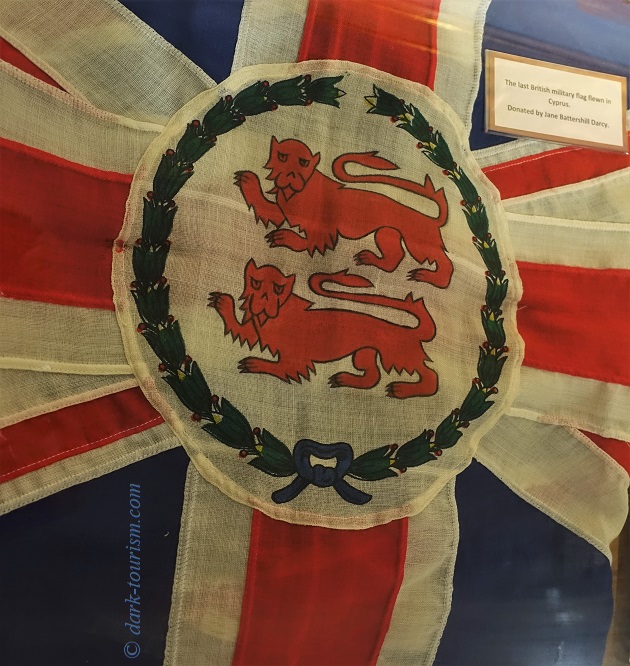
So much for this post. As I said, there will likely be a series of further posts about specific dark places within Cyprus with more elaborate photo essays to go with them, in particular for Varosha and Mitsero, but also the Green Line. Watch this space.

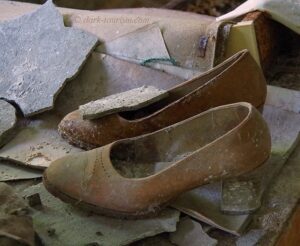


5 responses
Very nice! Definitely gives me a nudge not to procrastinate with a visit much longer. Maybe this year…! Looking forward to more posts!
Absolutely worth going! Good food too! I can give you more tips when you start planning concretely.
A very interesting and informative article on both sides of our Cyprus. Its well written and very informative.. A few years sgo I visited my home country of South Africa. I was privileged to see Robben Island where the late President of South Africa Nelson Mandela was imprisoned for 27 years. I was able to witness history and heartache. Thanks for the informative article.
Costa Constantinides limassol Cyprus.
thanks! I visited Robben Island too – many years ago, 2003 I think (goodness, that’s twenty years ago!), but it’s been very memorable indeed. We had a guide who had been an inmate of the prison there during Apartheid, and that made it additionally special and insightful.
Hi! Great article, thank you! I want to visit the red lake and I hope to do it this year.